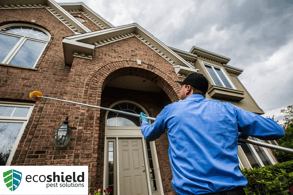Like most insects and bugs, the boxelder bug makes an appearance in the spring and hangs around until the temperatures begin to drop. This means that the summertime is the peak season for boxelders (outdoors), which may not come as a surprise to some. It may feel as if there are boxelders EVERYWHERE during the summer… trust us, it’s not just in your head! Find out what happens when the temperature drops and boxelder bugs look for shelter indoors.
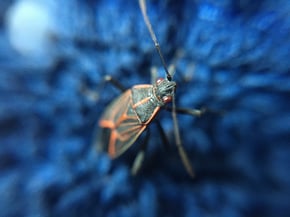
What are Boxelder Bugs?
The boxelder bug, or Boisea trivittata, is a North American species of “true bug.” True bugs are different from insects in a few ways, but most notably because they all have long, thin, straw-like mouths used for eating. Boxelders have a striking appearance with black, flat, and narrow bodies with bright orange or red markings. They are relatively small bugs, averaging just a mere ½ inch long in adulthood. Boxelder bugs have six legs, two wings, and two antennae. While they are commonly mistaken for a stink bug due to their similar appearance, the boxelder bug is a very different bug. You may also hear boxelders referred to as boxelder beetle or maple bug.
Boxelder bugs get their name from their favorite snack – the boxelder tree! Boxelder bugs enjoy feeding on female, seed-bearing trees by sucking out sap from leaves, soft twigs, and early-growing seeds.
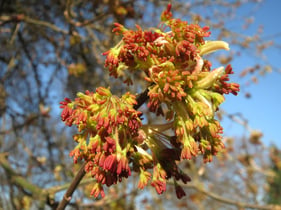
The Boxelder Bug Life Cycle
The Boxelder bug is a hemimetabolous insect, meaning it develops in three distinct life stages: egg, nymph, and adult.
Boxelder Eggs
In the spring, adult boxelder bugs will lay their eggs inside trees or even on their leaves. As prolific reproducers, adult boxelders can lay several hundred eggs at a time! These eggs are small, oval in shape, and generally are a rusty red-brown color. It is thought that the egg’s coloring acts as camouflage so they can blend in with their host tree and remain hidden from predators.
Boxelder Nymphs
In just a short two weeks, Boxelder nymphs will emerge from the eggs laid just days before. The nymphs closely resemble adult Boxelder bugs; however, the nymphs do not have wings. Throughout the summer, the Boxelder nymphs will experience several molts or shedding of their exteriors. After about five molts, the Boxelder nymph develops into a winged adult capable of reproducing.
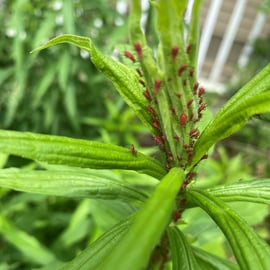
Boxelder Adults
As the weather grows cold, adult Boxelder bugs will seek a warm, habitable space for overwintering. They can fly as far as two miles in search of the perfect place to hibernate for the winter. Only fully grown adults will survive the winter and emerge again come spring in search of food. This is also when Boxelder bugs will begin their extremely prolific reproduction cycle, creating hundreds of more Boxelders each.
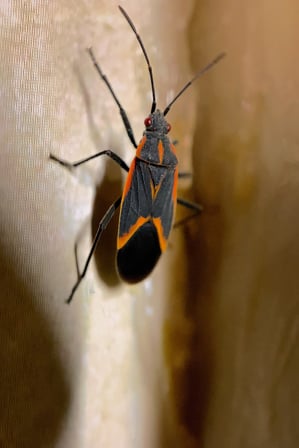
What impact can boxelder bugs have on my home?
Luckily, Boxelder bugs are considered a nuisance pest, which means they don’t pose any true harm or danger to humans. Boxelder bugs cannot bite or sting, nor are they likely to cause any significant damage to your garden or landscaping. Despite their significant population, it is very rare that Boxelder bugs will kill a plant or crop by overfeeding on it. In reality, Boxelder bugs are often more an annoyance than a true problem. However, that’s not to say Boxelder bugs are without issue.
A Boxelder bug’s excrement is known to stain light colored surfaces including sidewalks, outdoor seating, and even house siding. These stains can be very difficult to remove. In addition, Boxelder bugs also emit a strong and offensive odor when stepped on or otherwise crushed. These secretions are also quite foul tasting. Pets who accidentally (or intentionally) eat a Boxelder bug may vomit due to the bug’s foul taste and resulting unsettled stomach. While Boxelder bugs are not considered to be toxic to animals, we recommend that you contact your vet immediately if you suspect your furry friend has eaten a Boxelder bug.
During the warmer months, Boxelder bugs aren’t an immediate cause for concern. Their sheer population and quantity may be overwhelming, but in general, they pose no direct harm. It is as the weather begins to cool and temperatures drop that Boxelder bugs begin to become a problem to homeowners. As fall transitions to winter, Boxelder bugs are on the hunt for a warm place to overwinter. Unfortunately, your home may be the ideal destination.
While Boxelder bugs generally hibernate when they overwinter, if they find a consistently temperate place to reside, they may stay out and about all winter long. As most homes are heated throughout the winter to remain a comfortably mild temperature, Boxelders who find their way in may remain active throughout the winter. It is when Boxelder bugs have taken up residence in your home that they generally become a problem pest for homeowners.
How to prevent Boxelder bugs in your home
Thanks to their flat and arrow bodies, Boxelder bugs can enter your home through the smallest cracks and crevices. Some common entry points are poorly sealed windows and doors, gaps or spaces where utility lines connect to your home, and even underneath your home’s siding. While Boxelder bugs will opt for any home for refuge during the cold winter months, they tend to gravitate to homes on level ground that receive a lot of direct sunlight. While preventing Boxelder bugs from entering your home can be tricky, here are a few tips that will make it more difficult for Boxelder bugs to gain entry.
- First and foremost, contact a trusted pest solutions provider like EcoShield for existing or imminent infestations.
- Seal any and all cracks, gaps, holes, or spaces in the exterior of your home. Boxelder bugs will use these as entry points into your home.
- Replace seals and screens on your windows and doors.
- Where safe and possible, use mesh screens to block vents or other exterior access points.
- Consider using an at-home pest spray along the exterior of your home to act as a barrier. Please be sure to read the instructions and warnings on any at-home products thoroughly, especially if you have children or pets that live in your home.
- Vacuum up any Boxelder bugs you see, and be sure to empty the bag contents into a tightly tied trash bag, then remove the bag from the home.
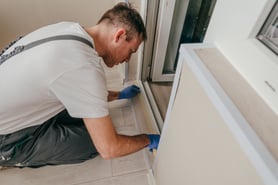
What should I do if I have a Boxelder bug infestation?
Sometimes, Boxelders can invade with little to no warning. If you find yourself with an active Boxelder bug infestation, we suggest you contact a reputable pest professional like EcoShield immediately. While a few bugs here or there may be able to be managed by a homeowner, true infestations can be difficult and very stressful to overcome. When your home is overrun with unwelcome visitors, give EcoShield a call.
EcoShield’s Home Shield Protection Plan protects you from all kinds of problem pests, including Boxelder bug infestations. Not only can EcoShield help rid you of Boxelder bugs in your home, but we will help prevent any pests (Boxelder bugs or otherwise!) from taking over your home. The Home Protection Plan promises four-season protection, keeping your home safe from Boxelder bugs and other problem pests all year round.
If you’re experiencing a Boxelder infestation or would like to safeguard your home from future invasion, give EcoShield a call today or fill out the form on this page. We offer free no-obligation quotes, excellent customer service, and guaranteed results.
